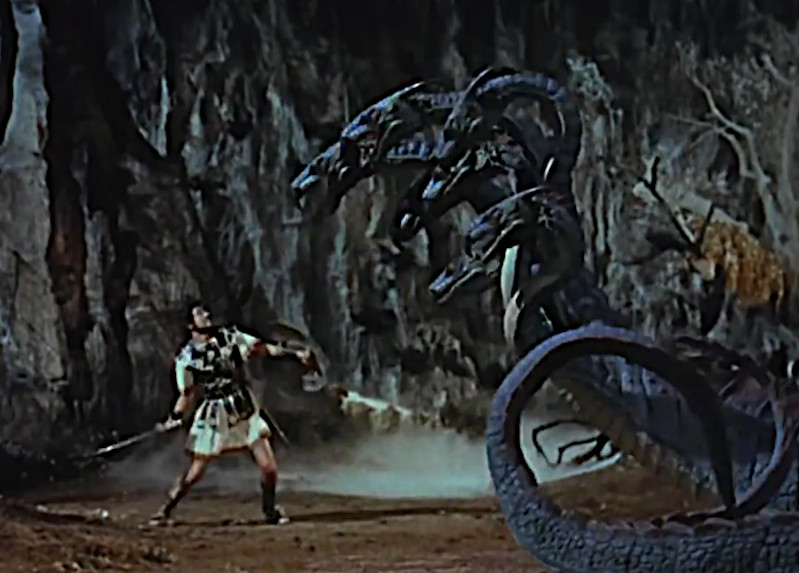A massively influential artist and filmmaker who inspired some of the greatest talents in the field, Ray Harryhausen was born 100 years ago today. He’s perhaps best known for his innovative work in stop-motion animation, particularly his own technique, dubbed Dynamation.
Stop-motion refers to the process of shooting one frame of a model, making adjustments, and then shooting another frame. As film moves at 24 frames per second, you created the illusion of motion. This technique was used by Willis O’Brien on 1933’s King Kong. That film inspired Harryhausen, and O’Brien became an early mentor, offering advice and critique of Harryhausen’s early work and encouraging him to take sculpture and art classes. After working on films for the Army during World War II, Harryhausen got his first featured job as assistant animator to O’Brien on 1949’s Mighty Joe Young. The film won the Academy Award for Best Visual Effects.
The trailer for The Beast from 20,000 Fathoms (which mentions the Post). (Uploaded to YouTube by Warner Bros.)
Harryhausen would push the envelope of effects in 1953. When he was given complete control over the effects in The Beast from 20,000 Fathoms, he was able to fully integrate his Dynamation process into the film. The technically demanding work involved shooting live-action backgrounds, then animating the stop-motion in front of those backgrounds to make it seems as if the action was occurring in a real-world location. Then the foreground action would be shot and added over the other footage, making it seems as if the live actors and backgrounds were existing in the same space, and interacting with, the models. On a theoretical level, it’s similar to what’s done today with shows like The Mandalorian, which shoot large chunks of scenes in a studio space called The Volume, employing previously shot footage that makes up a virtual background environment.
The Beast from 20,000 Fathoms is near to the heart of The Saturday Evening Post as the original Ray Bradbury story ran in the June 23, 1951 issue. In fact, by the time that Harryhausen worked on the film, he and Bradbury had been friends for years. The original title of the film was to be Monster from the Sea. When the studio discovered that Bradbury’s story also featured an undersea monster drawn to a foghorn, they bought the rights and retitled the film after Bradbury’s short. Ironically, the story would later appear in anthologies as “The Fog Horn,” rather than the film name. Nevertheless, the movie was a major hit at the time, opening more opportunities for Harryhausen and allowing him to continue to innovate with his techniques.
Throughout his career, Harryhausen displayed his genius for creature design and animation in films like It Came from Beneath the Sea, Earth vs. The Flying Saucers, and 20 Million Miles to Earth. All three of those were produced by Charles H. Schneer and became the foundation of a long-lasting and successful partnership. The duo also worked together on a trio of well-received (and much-loved) films based on Sinbad the Sailor of Middle Eastern legends: The 7th Voyage of Sinbad (1958); The Golden Voyage of Sinbad (1974); and Sinbad and the Eye of the Tiger (1977).
However, the film that Harryhausen himself thought of as his best was his 1963 collaboration with Schneer, Jason and the Argonauts. Directed by Don Chaffey, the film features several classic Harryhausen effects sequences. Empire magazine cited Talos from the film as the second greatest movie monster of all time in 2004. The film also contains the praised “skeleton army” sequence, winged harpies, and the many-headed hydra. Despite the advances in technology, the film retains a strong reputation; it was nominated for the American Film Institute’s Top 10 Fantasy Films list in 2008.
While some films were still using techniques that were similar to his, different methods pioneered by the very people whom he had inspired were replacing the kinds of effects that Harryhausen used. The list of those who say that they owe a debt to Harryhausen is staggering, including the likes of Tim Burton, Peter Jackson, George Lucas, Steven Spielberg, James Cameron, Guillermo del Toro, and Wes Anderson. Burton and director Henry Selick would collaborate on films like The Nightmare Before Christmas and James and the Giant Peach that used stop-motion techniques. When Harryhausen passed in 2013, Lucas released a statement that included a simple but massive truth, “Without Ray Harryhausen, there would likely have been no Star Wars.”
The legacy of Ray Harryhausen can be seen today in a variety of ways. The various “walkers” of the Star Wars universe are a tribute, and Peter Jackson’s remake of King Kong was directly inspired by O’Brien and Harryhausen. With his wife of 50 years, Diana, he started the Ray & Diana Harryhausen Foundation, which curates his collection and promotes stop-motion animation; his daughter, Vanessa, remains a trustee. His models and work continue to be exhibited at major museums, while books and podcasts are devoted to his artistry. Over time, he’s accumulated everything from induction into the Science Fiction Hall of Fame, to a star on the Hollywood Walk of Fame, to a special achievement awards from both the BAFTAs and the Oscars. The special effects of today may be so smooth as to almost be indistinguishable from reality, but it was the talent and inventiveness of people like Harryhausen that led, and by example continue to lead, the way.
Featured image: A scene from Jason and the Argonauts, where Jason combats a Hydra (Columbia Pictures / Public domain)
Become a Saturday Evening Post member and enjoy unlimited access. Subscribe now



